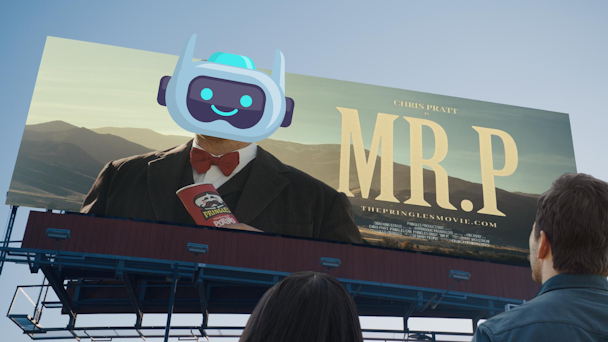What if you invested $20m in AI instead of a Super Bowl ad?
Code and Theory’s Dan Gardner wonders if marketers’ hard-earned budgets would have been better spent laying the groundwork for AI than on a Super Bowl ad campaign.

Chris Pratt in the Pringles film, albeit with a robot head thus visualizing Dan's Super Bowl v AI dichotomy
Farting horses. People running into walls. Celebrities, celebrities and more celebrities – so many celebrities. This is what we get every year from the Super Bowl.
I am not anti-Super Bowl. The game is an immense cultural moment and the only event where people sit in a room talking about ads. I’m also not anti-30-second spots (or 15, 10 or five). I’m not anti-branding or anti-traditional marketing.
There is a time and place for all of this, for the most part.
But I am struck by the cost, but not in the way that you think. I question whether some brands are investing in the hype and excitement provided by seconds of Super Bowl airtime at the expense of a much greater opportunity.
Let’s start with the actual dollars. From Chris Pratt’s Pringles ad to the Kris Jenner’s Oreos one, you have to pay up. Then there are the production costs, the PR bills and, of course, the $7m for 30 seconds of air time. So all in, we are talking about $20m for an ad that could ultimately bomb or, worse, become instantly forgettable.
I mean, seriously, can you name three ads from last year? [Editor’s note: Yes, but not four.]
Advertisement
The short-term press and ad meters are exciting. And I get that there aren’t many cultural live moments you can buy. But right now, there is a once-in-a-lifetime generational shift happening thanks to AI. This is a before-and-after moment where the companies that invest properly in AI will leapfrog their competition.
I’m not talking about cost efficiencies and expediting rote tasks. Yes, that’s happening, but too much time has been spent discussing the impact of AI on the labor force. We all know AI is being used for storyboarding, pre-planning for production shoots and tasks like that. Those are table stakes at this point.
The bigger opportunity is how AI will impact the future of a brand experience. As content becomes more pervasive (if that’s even possible), a strong brand will become more valuable than ever. AI will assist by creating private, competitive data (built off of a company’s existing data).
Advertisement
It allows brands to look at customers’ past behavior and anticipate their needs by offering content, products and experiences they didn’t even know they wanted. It allows businesses to turn their platforms into branding superpowers.
The attention economy is changing – again. The past decade has focused on the traditional three screens. Now, we are seeing new tech coming to market from AI-enabled devices like Rabbit and smart glasses from Ray-Ban. There are transparent embedded screens and, of course, Vision Pro and Meta Quest. And don’t forget the new, obvious platforms, even on traditional screens, like ChatGPT.
I get the eye rolls as you read this. Most of this tech is early and clunky. But, may I remind you that the early internet was hardly usable with dial-up and chat rooms. Early smartphones didn’t have app stores. Social media didn’t have news feeds. However, each of these advances led to new behaviors and massive business opportunities.
Suggested newsletters for you
I don’t profess to know the future, but what I can say with certainty is that if your brand isn’t racing to be ready for the change, it will be threatened.
Back to the cost of opportunity. Do you know what will help businesses set themselves up for real success? A $20m investment in technology and innovation. Specifically, an investment in two areas:
Data and tech stacks
Get your data in order. Get your tech stack in order. It’s amazing how many brands don’t have a handle on this. Despite two decades of "data lakes," everyone’s data is still siloed and almost unusable. Those leveraging AI will win when it has access to structured data. This is foundational to being able to leverage AI and adapting quickly.
Customer relationships
Behaviors are changing. AI enables new types of interaction that were inconceivable in the past. Now is the time to take real creativity, come up with new ideas that will create brand engagement and then use AI as a multiplier. Stop focusing on AI coming for your present-day job. Instead, use AI to create a vision for the future of your company, your customers and yourself.
A brand is the sum of all its interactions. Every interaction defines the brand. AI is the great consolidator. It finally allows us to fully realize the vision of creating amazing experiences united across touchpoints. AI will also consolidate responsibility inside siloed businesses, meaning the role of the CMO, more than ever, will need to lean into a technology-enabled creative mindset.
Tech-enabled creativity is coming whether we want it or not. This doesn’t mean the end of creativity. It means the beginning of a new chapter of what it means to be creative.
And listen, for some businesses, there is a place for traditional Super Bowl ads. It’s fun for a creative to make a film seen by hundreds of millions of people at one moment in time.
This approach is useful for industry giants with budgets that can accommodate both significant short-term and long-term investments. However, not every company is a consumer packaged goods behemoth.
For the majority, it would be prudent to question the wisdom of pouring tens of millions into a single event if you don’t have the same rigor and investment in technology. The opportunity cost of neglecting technological advancements and data-driven strategies will be far more detrimental in the long run. It’s common sense.

